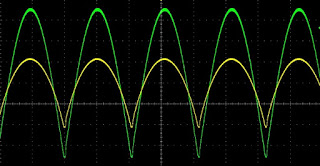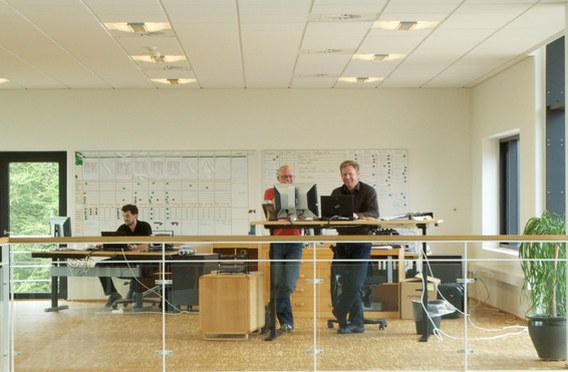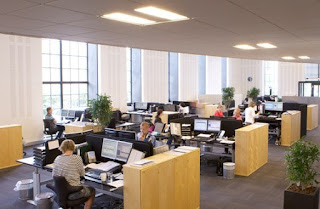
Professor Wilkins says it’s ‘plain enough’ that bad flicker from magnetic ballasts in schools can impair learning. A switch to high frequency gear, or LED luminaires, would fix the problem.
Four fifths of British school children are having their learning impaired and are at risk from anxiety, migraines, headaches and even dyslexia from flickering lighting, an expert scientist has warned.

Because of the way magnetic ballasts manipulate the 50 Hz sinusoidal waveform of the input voltage, they deliver a light output that flickers at 100 Hz. This frequency is in the danger zone of harmful flicker, which could impair learning.
Arnold Wilkins, emeritus professor at the University of Essex and a leading expert in photosensitivity and physiology, says distracting flicker in the UK’s schools needs to be addressed.
‘Unfortunately 80 per cent of our schools are still lit with lighting that flickers at 100 hertz’, he told a Lux conference on lighting fixture design in London this month. ‘It causes headaches and its causes anxiety. It’s there all the time. Whether it impairs their learning, seems to me to be plain enough.’
Although people can only directly perceive fluctuations at frequencies up to about 70 Hz, human vision is adversely affected by light fluctuations up to 200 Hz. Visual performance is especially degraded by flicker in the 100 Hz to 200 Hz range and in general, younger people are likely to perceive lower level and higher frequency flicker than older observers.

Professor Arnold Wilkins says that 100 Hz is present all the time under magnetic ballasted fluorescent fittings in schools. ‘Whether it impairs their learning, seems to me to be plain enough’ he told the Lighting Fixture Design Conference in London.
‘There’s a huge range of susceptibility in the population with those [who get] migraines at one extreme. And it probably contributes to dyslexia but we don’t know for certain.
‘100 hertz should be avoided.’ The solution is to upgrade to high frequency control gear for fluorescent or LED. ‘It’s a simple as that.’
Flicker at 100 Hz is prevalent in older fluorescent light fittings with magnetic ballasts which were popularly installed in schools before the introduction of high-frequency electronic control gear and LED panels. Typically, magnetically ballasted fluorescent luminaires will exhibit flicker of between 10 and 20 per cent of output, and a ‘compact flicker degree’, or CFD, of over 20 per cent. Prolonged exposure leads to eyestrain, headaches and anxiety.
Professor Wilkins has a number of high profile awards to his name, including the Leon Gaster Memorial Award, the Walsh Weston Memorial Award and the Owen Aves Medal and has been made a honorary fellow of the College of Optometry.
LED Ceiling panels are available from Novel Energy Lighting. We stock multiple quality brands, such as Thorn, Ansell, Philips, and MEGE:
flicker free · led 600x600 · LED Ceiling Panels · led flcker · led panels · low flicker · Novel Energy Lighting · school lighting
Modern offices are increasingly dominated by display screen technology. Whilst appreciable quantities of paper documents are still in use they are normally in association with computers, and this balance is gradually moving toward increasing display screen use and decreasing quantities of written or printed text. A side-effect of this is the reduction in the amount of filing requirements as documents are stored on a computer disk.

This has resulted in a change in office furnishings with fewer storage cabinets and an increase in technology, and also in a fundamental shift in task position, from predominantly horizontal documents to predominantly vertical display screens.
Additionally in many offices collaborative working is encouraged where formal or informal face-to-face discussions occur to consider short-term issues or long-term plans.

Building design has also developed as energy costs and sustainability issues gain importance, resulting in a high proportion of modern office space receiving significant levels of daylight.
Best practice
These changes impact all aspects of the design of modern office building services including artificial lighting. Lighting must be designed to prevent disturbing reflections on display screens, requiring a high level of optical control and technical competence in luminaire design. Lighting must also provide adequate illuminance to occupant’s faces, modelling features sympathetically and therefore allowing good visual as well as aural communication. This interplay of display screen versus human requirements needs careful planning of a lighting installation to produce a fulfilling space suitable for the task. Recommendations for lighting for DSE and also for modelling of faces and vertical surfaces are provided in the European Standard EN 12464-1:2011 Light and lighting – Lighting of work places Part 1: Indoor work places.
EN12464-1 provides recommended illuminance levels for a variety of office tasks. These illuminance values are task related and best practice is to layer the lighting levels, balancing the level on the task, the level on the surrounding area and the level on the background. It has been shown that the perception of how light or gloomy a space appears is based upon a 40° band in front of the viewer. This is generally the room walls and a portion of the ceiling. It is therefore important that room surfaces are lit to prevent a gloomy, oppressive ambience and EN 12464-1:2011 recommends an average illuminance of 75lx on the walls and 50lx on the ceiling.
Taking control
Supplying comfortable and effective light is not the same as supplying controlled and energy-efficient light. A lighting system should interact with the space, dimming in response to increasing levels of daylight, turning on or off in response to occupancy within the space, and with increasing use of technology, especially within meetings, allow lighting scenes to be set to provide the optimal conditions for the task at hand. Lighting should be an integral part of the office ambience, giving a calm or lively atmosphere dependant upon the needs of the task and space, providing a fulfilling workplace for people to enjoy and be stimulated in, benefiting both the individual and the business.
Call us today to discuss your office lighting needs, tel: 0208-540-8287, or email: sales@novelenergylighting.com. We supply a full range of LED panels, tubes, and downlights suited to office requirements. Visit us at www.novelenergylighting.com to explore our range of Thorn LED products.
led 1200x300 · led 1200x600 · led 600x600 · LED downlights · led panels · led tubes · Novel Energy Lighting · office led · office lighting · thorn led · thorn lighting






